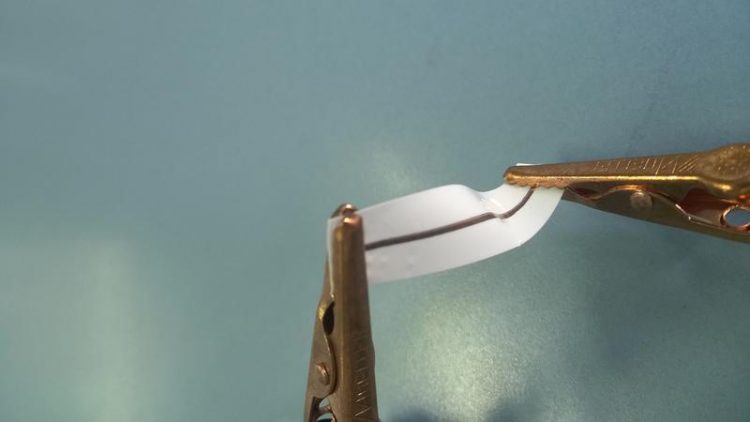Hannover Messe: Successful small-scale production of new hybrid inks

Flexible electronics with hybrid inks Source: INM; free within this press release
Conductive inks are widely used in to print electronics. They are suitable materials for flexible photovoltaics, lighting, touch screen electronics, wearable devices, large-area heaters, sensors, 3D conformal antennas, and health and biomedical applications, among others. Existing inks require annealing after inkjet printing before they become conductive.
“Our new hybrid inks become conductive immediately upon drying, are mechanically flexible, and compatible to inkjet printing,” explains the INM materials scientist Tobias Kraus.
“The hybrid inks contain a small organic polymer fraction that helps to maintain its electrical conductivity, even if the substrate material is bent,” Kraus continues. This enables printing on almost any substrate, like foil, paper, or textiles, since the final annealing steps at relatively high temperatures are avoided.
INM scientists have recently scaled the production of these hybrid inks to a level that is sufficient for small-scale production. “The scaling of nanostructured products requires optimized processes in order to maintain quality while lower prices,” says Kraus. Samples of the material are now available for testing applications.
Your expert at INM
Prof. Dr. Tobias Kraus
INM – Leibniz-Institute for New Materials
Head Structure Formation
Deputy Head InnovationCenter INM
Phone: +49681-9300-389
tobias.kraus@leibniz-inm.de
INM – Leibniz Institute for New Materials, situated in Saarbrücken, is an internationally leading centre for materials research. INM conducts research and development to create new materials – for today, tomorrow and beyond. Research at INM is performed in three fields: Nanocomposite Technology, Interface Materials, and Bio Interfaces. INM is an institute of the Leibniz Association and has about 240 employees.
Media Contact
All latest news from the category: Trade Fair News
Newest articles

First-of-its-kind study uses remote sensing to monitor plastic debris in rivers and lakes
Remote sensing creates a cost-effective solution to monitoring plastic pollution. A first-of-its-kind study from researchers at the University of Minnesota Twin Cities shows how remote sensing can help monitor and…

Laser-based artificial neuron mimics nerve cell functions at lightning speed
With a processing speed a billion times faster than nature, chip-based laser neuron could help advance AI tasks such as pattern recognition and sequence prediction. Researchers have developed a laser-based…

Optimising the processing of plastic waste
Just one look in the yellow bin reveals a colourful jumble of different types of plastic. However, the purer and more uniform plastic waste is, the easier it is to…



